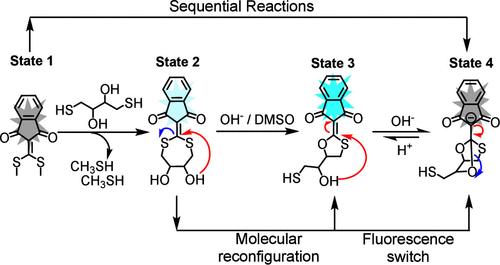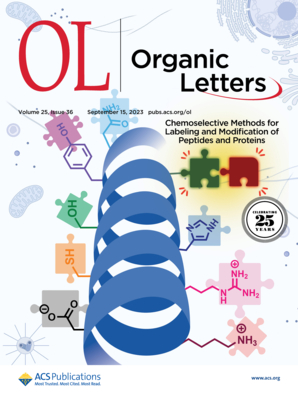Oxa-/Thiol-Michael共轭加消反应驱动的序列动态荧光开关
IF 5
1区 化学
Q1 CHEMISTRY, ORGANIC
引用次数: 0
摘要
报道了一种通过分子内氧/巯基michael共轭加消反应进行序列重构和多态荧光切换的动态分子体系。由化学、溶剂和最重要的pH刺激依次触发,通过比例吸收/荧光和核磁共振光谱监测不同分子状态的受控过程。这种刺激控制的荧光开关显示了实时监测过程的实用性,如化学诱导的聚合物降解。本文章由计算机程序翻译,如有差异,请以英文原文为准。


Sequential Dynamic Fluorescence Switching Driven by Oxa-/Thiol-Michael Conjugate Addition–Elimination Reactions
A dynamic molecular system undergoing sequential reconfiguration and multi-state fluorescence switching via intramolecular oxa/thiol-Michael conjugate addition–elimination reactions is reported. Triggered sequentially by chemical, solvent, and most importantly pH stimuli, the controlled progression through distinct molecular states was monitored by ratiometric absorption/fluorescence and NMR spectroscopy. This stimulus-controlled fluorescence switching demonstrates utility for real-time monitoring of processes, like chemically induced polymer degradation.
求助全文
通过发布文献求助,成功后即可免费获取论文全文。
去求助
来源期刊

Organic Letters
化学-有机化学
CiteScore
9.30
自引率
11.50%
发文量
1607
审稿时长
1.5 months
期刊介绍:
Organic Letters invites original reports of fundamental research in all branches of the theory and practice of organic, physical organic, organometallic,medicinal, and bioorganic chemistry. Organic Letters provides rapid disclosure of the key elements of significant studies that are of interest to a large portion of the organic community. In selecting manuscripts for publication, the Editors place emphasis on the originality, quality and wide interest of the work. Authors should provide enough background information to place the new disclosure in context and to justify the rapid publication format. Back-to-back Letters will be considered. Full details should be reserved for an Article, which should appear in due course.
 求助内容:
求助内容: 应助结果提醒方式:
应助结果提醒方式:


